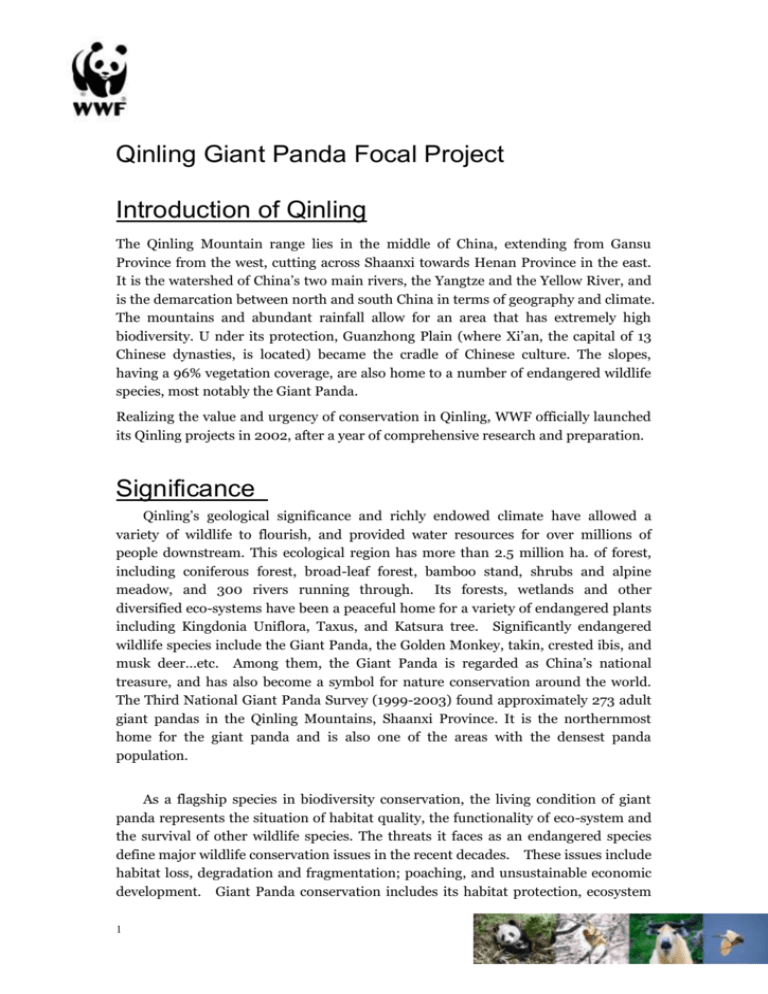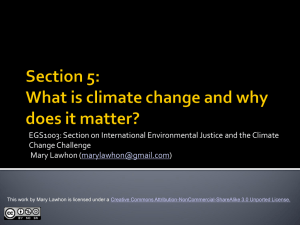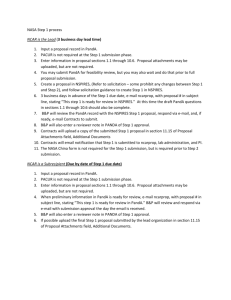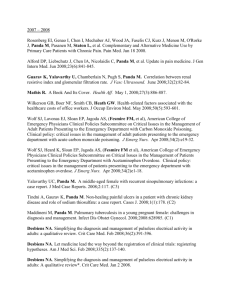Qinling Giant Panda Project
advertisement

Qinling Giant Panda Focal Project Introduction of Qinling The Qinling Mountain range lies in the middle of China, extending from Gansu Province from the west, cutting across Shaanxi towards Henan Province in the east. It is the watershed of China’s two main rivers, the Yangtze and the Yellow River, and is the demarcation between north and south China in terms of geography and climate. The mountains and abundant rainfall allow for an area that has extremely high biodiversity. U nder its protection, Guanzhong Plain (where Xi’an, the capital of 13 Chinese dynasties, is located) became the cradle of Chinese culture. The slopes, having a 96% vegetation coverage, are also home to a number of endangered wildlife species, most notably the Giant Panda. Realizing the value and urgency of conservation in Qinling, WWF officially launched its Qinling projects in 2002, after a year of comprehensive research and preparation. Significance Qinling’s geological significance and richly endowed climate have allowed a variety of wildlife to flourish, and provided water resources for over millions of people downstream. This ecological region has more than 2.5 million ha. of forest, including coniferous forest, broad-leaf forest, bamboo stand, shrubs and alpine meadow, and 300 rivers running through. Its forests, wetlands and other diversified eco-systems have been a peaceful home for a variety of endangered plants including Kingdonia Uniflora, Taxus, and Katsura tree. Significantly endangered wildlife species include the Giant Panda, the Golden Monkey, takin, crested ibis, and musk deer…etc. Among them, the Giant Panda is regarded as China’s national treasure, and has also become a symbol for nature conservation around the world. The Third National Giant Panda Survey (1999-2003) found approximately 273 adult giant pandas in the Qinling Mountains, Shaanxi Province. It is the northernmost home for the giant panda and is also one of the areas with the densest panda population. As a flagship species in biodiversity conservation, the living condition of giant panda represents the situation of habitat quality, the functionality of eco-system and the survival of other wildlife species. The threats it faces as an endangered species define major wildlife conservation issues in the recent decades. These issues include habitat loss, degradation and fragmentation; poaching, and unsustainable economic development. Giant Panda conservation includes its habitat protection, ecosystem 1 conservation and other wildlife protection, which in the long term ensures the rich biodiversity in the region. In Qinling, WWF hopes to integrate with national projects to strengthen traditional conservation and promote conservation-based sustainable development in nearby communities so that the Qinling giant panda can, and also to improve the local economy. Efforts and Achievements 1. Qinling Focal Project Phase I Since 2001, in conjunction with the Shaanxi Government, Forestry Department, and Tourism Department, as well as other related conservation agencies, WWF has worked in Qinling, China, focusing on giant panda conservation and local economic development. The project works in 3 parts: Module A focused on cooperation with local conservation institutions to promote the creation new panda nature reserves, and to create ecological corridors for the Qinling panda populations in order to ensure the species’ long-term survival and breeding. Module B focused on the relationship between conservation and sustainable development in Qinling’s South Taibaishan region, with the objective to mitigate further loss and fragmentation of panda habitats caused by tourism development. Module B also served to meet conservation needs of the giant panda, as well as Xi’an municipality’s Heihe River’s drinking water supply. Module C geared towards establishing a local community-based development network in and around panda habitats. Achievements Established 8 new giant panda nature reserves and 5 corridors, increased protected giant panda habitat by 180,606 hectares; 1. Equipped 8 newly-established nature reserves and 2 corridors with monitoring and patrolling outfits; 2. Assisted 8 newly-established nature reserves and 2 corridors in developing their management plans; 2 3. Supported 8 newly-established nature reserves and 2 corridors to carry out capacity building training; 4. Supported 1 nature reserve to upgrade to provincial reserve; 5. Supported 1 forest farm to carry out monitoring and patrolling, making it the only monitoring and patrolling forest farm in Shaanxi Province; 6. Created a community-managed model in 1 corridor; 7. 92 households benefited from a bee-keeping project, the production of honey increased by 10 kg/box and income increased by RMB 500/year; 8. 120 households benefited from a wood-saving stove project, the consumption of wood reduced by half, about 60 mu mature woods/year (1 mu=0.07 hectare); 9. 378 households benefited from a Crested Ibis green rice project, local people increased their income by RMB 100/mu and protected the Crested Ibis; 10. 42 households benefited from a home-stay tourism project, each household’s income increased by RMB 2,000/year; 11. Supported the development of the Master Plan for Conservation and Eco-tourism in Southern Taibaishan Mountain, the first regional plan for conservation and eco-tourism in Shaanxi Province; 12. Supported the building and improving of 8 eco-tourism establishments; 13. The income from eco-tourism in the Qinling project area increased by 20%; 14. Employment in the Qinling project area increased by 20%; 15. Presented Qinling as the 83rd Gift to the Earth. 2. Qinling Focal Project Phase II WWF’s Qinling Focal Project Phase II aimed to encourage conservation-based economic development in the Qinling mountain forests while supporting the establishment of nature reserves. The project worked to incorporate environmental conservation into regional developments of Qinling, as well as tackled watershed preservation. The project consists of two modules: Module A: Watershed protection and habitat conservation (giant panda) The objective of Module A is to ensure optimal watershed functioning and improved quality for nature wildlife habitats in the Qinling mountain range. Major activities : 1. Qinling giant panda monitoring and patrolling network 2. National Highway 108 Qinling Tunnel wildlife corridor and giant panda habitat restoration 3. Establishing new giant panda nature reserves 3 4. 5. Sustainable forest management Capacity building for established nature reserves Module B: Conservation based economic development Module B aimed to introduce eco-tourism in Southern Taibaishan region and sustainable community development. The Southern Taibaishan region of the Qinling Mountains is home to the world’s densest giant panda population and the only water source of Xi’an city. The ecotourism project aims to create a balance between conservation and sustainable development in the region, and mitigate further loss and fragmentation of panda habitats, with special consideration for the the giant panda population and the water supply of Xi’an City. The project explored partnerships with local governments, conservation, agriculture and poverty alleviation departments and enterprises, so that collaboration efforts would reap mutually beneficial results for nature conservation and the sustainable development of local communities. Overall, the project succeeded at stabilizing or increasing incomes for forest farms, villagers and micro-entrepreneurs for pilot sites from 2004-07, without disturbance to wildlife habitat and watershed quality. Major activities: Southern Taibaishan tourism greening Introduce sustainable tourism development theory and practices, improve the quality of existing tourism; Enhance the tourism marketing for tourism operators, train in marketing and reception skills; Improve the tourism facilities, support the building of a panda hotel, eco-friendly bamboo lodge, eco-trail, reflection garden and tourist information centre etc.; Provide environment education and the mechanism for returning tourism profits back to conservation; Explore alternative development approaches for former logging enterprises. Sustainable community development Improve the local living and production situation; Adjust the local living and production habits, guide them to develop conservation-based industry, such as wood-saving stoves, home-stay hotels, green rice, new way of bee-keeping. Achievements: 1. Supported the compiling of the Comprehensive Conservation and Management Plan of Qinling Giant Panda and its Habitat; 2. Supported Shaanxi Forestry Department and 20 nature reserves to carry out giant panda and its habitat monitoring and patrolling work in Qinling and provided scientific data for the overall conservation & management work; 4 3. Provided more than 260 monitoring equipments and 8 trainings on provincial monitoring and patrolling work; 4. Assisted the establishment of 3 panda nature reserves and now there are 19 panda nature reserves and 1 forest farm in Qinling, and the protected area reaches 526,645 ha; 5. Supported the Qinling Tunnel Giant Panda Habitat Management Project to unite two panda sub-populations across the national road 108 by planting 100 ha. bamboo forest and providing alternative livelihood to the communities; 6. Supported Heihe Provincial Forest Park to upgrade to National Park through capacity building and facility improvement; 7. Promoted the concept of sustainable forest practice and complied the management plan in one pilot forest farm; 8. Supported the established of Education Centre and Bamboo Lodge in Laoxiancheng Nature Reserve to provide conservation education to tourists and generate more income for panda conservation work. Also it is a platform for capacity building as well as job opportunities; 9. Organized two Qinling Youth Ambassador activities and sent over 500 college students to the communities neighboring giant panda habitat during the summer time. More than 100 technical trainings are provided, together with over 5000 leaflets on farming and animal husbandry; 10. Published 7 editions of Qinling Magazine on wildlife and nature reserves in Qinling to promote the overall communication regarding Qinling conservation; 11. Launched 10 small credit projects in communities to generate more income for villagers and reduce their over-reliance on the natural resources; 12. Supported the joint anti-poaching campaign in Qingmuchuan Nature Reserve to address the poaching, logging and other illegal activities in cooperation with two other nature reserves in Sichuan, and Gansu province. The campaign also inspected over 200 restaurants and distributed 2000 leaflets; 13. 10 households benefited from a home-stay tourism project in the crested ibis area, and each household’s income increased by RMB 10,000/year; 2 ventilation cells are built for fruit storing and each household benefit over RMB 20,000/year. A crested ibis watching tower as well as 1200m long fence are built to mitigate tourist disturbance to the crested ibis; 14. By July 2007, WWF supported over 150 conservation and development projects with 60 partners. 519 energy-saving stoves are built, 63 home-stays are supported, and 241 households benefited from the bee-keeping. Over 100 trainings are provided with 5540 villagers benefited; 15. By July 2007, 24 publications are compiled and distributed to relevant audience, including Traditional Herb Medicine Plantation, New Method of Bee-keeping, Giant Panda and its Habitat Monitoring and Patrolling, etc 3. Qinling Focal Project Becomes Green Heart of China Stepping into its seventh year of conservation work in 2010, the Qinling Project merged into the overall collaboration network named Green Heart of China, with work 5 scope expanding from the original giant panda and habitat conservation to overall giant panda landscape conservation, covering forest, wetland, and other endangered species including golden monkey, crested ibis, traditional Chinese medicine. Major work included: WWF supported Shaanxi Forestry Department and relevant giant panda nature reserves to establish an integrated giant panda conservation network by establishing more nature reserves and creating panda corridors so that all habitats are under the same unified management; WWF supports effective management of the Qinling giant panda conservation network via comprehensive monitoring and patrolling work in the field; WWF initiates comprehensive giant panda corridor recovery and conservation work to ensure the connectivity of the habitat. WWF promotes forest protection as part of giant panda habitat landscape conservation by introducing the concept of sustainable forest management, collective forest management and high conservation value forest identification, and actively piloting projects in the field. Based on the needs of giant panda nature reserves, WWF conducts capacity building projects to enhance the staff’s ability in project management and implementation. WWF promotes responsible eco-tourism in place of mass tourism in ecologically fragile areas to minimize the negative impact of human disturbance on the giant panda habitat. WWF supports conservation-based development in communities neighboring giant panda habitat via the introduction of alternative livelihoods and alternative energy sources, including beekeeping, home-stays, cash tree plantation, energy-saving stoves and bio-gas pool building to generate more income and ensure sustainable nature conservation work. WWF supports wetland ecosystem conservation and at the same time promotes sustainable development in the communities to ensure long-term protection of the crested ibis and other wildlife. Conduct environmental education activities to raise environmental protection awareness so communities can participate in the conservation work. - Goals: Please refer to Green Heart of China’s Vision and Goals. -Objectives: 6 By 2030, threats that cause the degradation, loss and fragmentation of giant panda habitats will be comprehensively managed and large scale human activities affecting the survival and reproduction of giant panda will be effectively decreased or eliminated. 7 The size of existing nature reserves will be increased, optimized and well managed, and potential habitats will be largely expanded. More essential corridors will be established, through which the fragmented patches of the Qinling landscape will be integrated as a whole network for free migration and gene exchange of giant panda individuals from one to another. The giant panda population will be increased to a safer level. Pioneering alternative energy and livelihood sources, a sustainable socio-economic development system will be fully established in local communities. An ecological compensation and restoration mechanism will be fostered, and consultation as well as education will be promoted to significantly benefit the public. A policy and general public support system will be founded for giant panda conservation and the environment. Functional ecosystems like forest, shrub, grassland, wetland, lakes, and relevant key rare and/or endangered species like golden monkeys, and crested ibis will be comprehensively conserved at a landscape level. People will live in harmony with nature.





